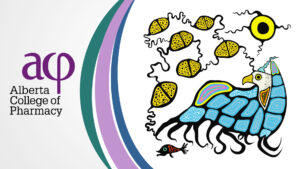
Pharmacists across Alberta are making a difference in the opioid crisis every day, one patient at a time.
As you’ll see in these examples, little things can sometimes make a big difference.
Ayman Abd Elshahid, Red Deer
When Alberta Health Services opened an addiction services and prevention clinic in central Alberta, community pharmacist Ayman (George) Abd Elshahid saw it as an opportunity. He knew some of his patients might have had possible addiction issues with prescription opioids and hoped he could help. Since then, Ayman has had success referring patients to the clinic.
While it’s not an easy topic to bring up, the first steps in the process after identifying the problem, says Ayman, is talking and offering help to your patient.
“I had a patient who had an opioid abuse problem,” he said. “He had looked for early release of his medications many times. One day, he came to me and asked for his regular refills. After talking to him about the risks associated with exceeding the prescribed doses and that this is a problem he might be facing, I told him if he felt he needed assistance, I would be happy to offer him some options.”

At first, Ayman’s patient resisted and insisted he was fine. The next time the patient came to the pharmacy, he wanted to know about what kind of help Ayman could offer. This time, the patient brought up his ongoing addiction issues with other street drugs as well.
“I told him about the clinic and that they offered great, confidential services, they could help him through the process, and that they have had good success with other patients,” said Ayman. “The patient contacted the clinic and set up an appointment. He and his spouse both started on daily doses of Suboxone. I started doing assessments for the patient. We communicated very well with the help of the doctor and nurse practitioners at the clinic. It was a good start.”
Ayman feels strongly that none of this would have been possible if he had not already established a strong, professional relationship with his patient.
“It doesn’t come on the first day. It takes time and confidentiality must be assured,” he said.
“The patient must trust you. Building that trust makes a big difference. Patients feel your attitude towards them. I care about all my patients and I’m here to help them.”
According to Ayman, it’s his responsibility as a pharmacist to intervene if he feels a patient is at risk of addiction or opioid misuse. He also says pharmacists shouldn’t feel pressure from a patient to issue early release of a medication. And if a patient asks for early release, Ayman says pharmacists should explain the risks to the patient and share that fact within the patient’s circle of care.
“As a pharmacist, I feel that I just did my job,” he added. “I think about the person in front of me and that I should use all available resources to help them. But personally, I am proud that I helped save someone’s life.”
Katie Swan, Edmonton
As ACP’s new opioid guidelines came into effect on October 1, 2017, Edmonton community pharmacist Katie Swan believed it was a change for the better. She saw it as an incentive to use her scope of practice more to improve the way she documented her assessments. It was also an opportunity to collaborate more with other healthcare providers, particularly physicians. So far, her experiences with collaboration have been mixed, but she does have reason for optimism.
Recently, while assessing a patient with an opioid prescription, Katie discovered the patient was taking two different opioid medications for two different types of pain. She explained to the patient that because her two prescriptions added up to more than the accepted daily oral morphine equivalent dose, she would have to contact her physician. Katie explained to the physician why she was reaching out and how she was complying with the new ACP opioid guidelines, and asked what she could do to help care for their mutual patient.
“I found that really opened the communication lines,” said Katie. “The physician was really open to telling me that she was already hoping to decrease the dose, and asked me what I would recommend and what I could do on my end. From there, I talked to the patient again, asked her what she had tried before, what she would be willing to do to change her pain management, and found there were some areas she could decrease her dose. I contacted the doctor again and the dose was decreased. The patient is adjusting to the lower dose and we will continue to follow up to see how her pain is being managed.”

For Katie, it felt good to work so well with another healthcare professional for the benefit of their patient.
“I was excited that the doctor appreciated my feedback and we could actually collaborate on something, because we need that collaboration,” said Katie.
“It felt good to be listened to and for her to ask for my opinion. Sometimes you feel that physicians have their own treatment plan and they know exactly what they’re doing, but sometimes an outside opinion is good for the patient as well.”
Katie feels pharmacists have a crucial role to play during the opioid crisis, and she accepts the responsibility.
“There is definitely a place for pharmacists to help,” she said. “We do have the knowledge about opioids and pain management, so we should use the knowledge we have and pass it on to patients and physicians. I think it can be uncomfortable at times. But we do have to make sure we understand the patient’s side of things. It’s something to adapt to, understand, and be empathetic with.”
Joshua Torrance, Red Deer
In addition to his hospital practice, Joshua Torrance runs QlinicalRx, a company that helps pharmacy teams deliver patient care through a variety of online tools. When ACP’s opioid guidelines took effect in October, Joshua not only created an Opioid & Pain Care Plan Tool, but made it available to all pharmacy professionals—for free.
“A lot of our customers were requesting it,” said Joshua. “Given the magnitude of the problem, we decided to publicly release it. We saw a need for pharmacists everywhere to benefit from it, not just our subscribers.”

During development, Joshua and the QlinicalRx team attempted to build a tool that works well, integrates into workflow, meets documentation requirements, and produces a usable result that contributes to good communication among pharmacy team members. They believe that’s what they’ve achieved with the Opioid & Pain Care Plan Tool.
When you first access the tool, you have the option of creating an initial assessment or a follow-up assessment. The initial assessment includes fields for information such as location, description and etiology of pain, goal of therapy, current and past therapies, risk screening, safety and adherence, planning, monitoring, and follow-up.
The follow-up assessment section includes rating the efficacy of therapy, noting adverse effects, monitoring for abuse/dependence, and updating planning, monitoring and follow-ups.
Pharmacists can fill out whatever information is relevant to them and their patients.
“You can never get every single patient to fit into one form,” said Joshua.
“Not everything applies to everyone. We really try to make it customizable. It’s going to guide you down the best practice, but if you need to divert from that, it gives you that ability. It’s not going to force you to do things that don’t apply to your patient.”
So far, reaction from pharmacists who have tried the tool has been positive.
“A lot of people were overwhelmed because they really haven’t sat down and looked at how they do an opioid assessment in five or 10 years,” said Joshua. “This framework helps them communicate with their staff, so everyone is on the same page. That same information is easy to use in their own documentation or if they’re communicating with other healthcare professionals, such as physicians. They like that they have a standard format to work with.”
Joshua hopes the tool allows pharmacists to spend more time assessing patients and less time doing paperwork, especially considering that pharmacists are on the front lines of the opioid crisis.
“The opioid crisis is a big societal problem, but at its roots, it’s a drug-related problem,” he said. “I think pharmacists are well positioned with knowledge and skills to deal with it. We have a big role we can play.”




